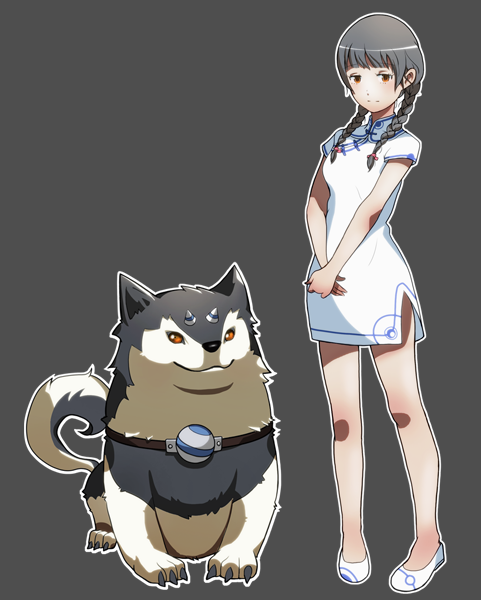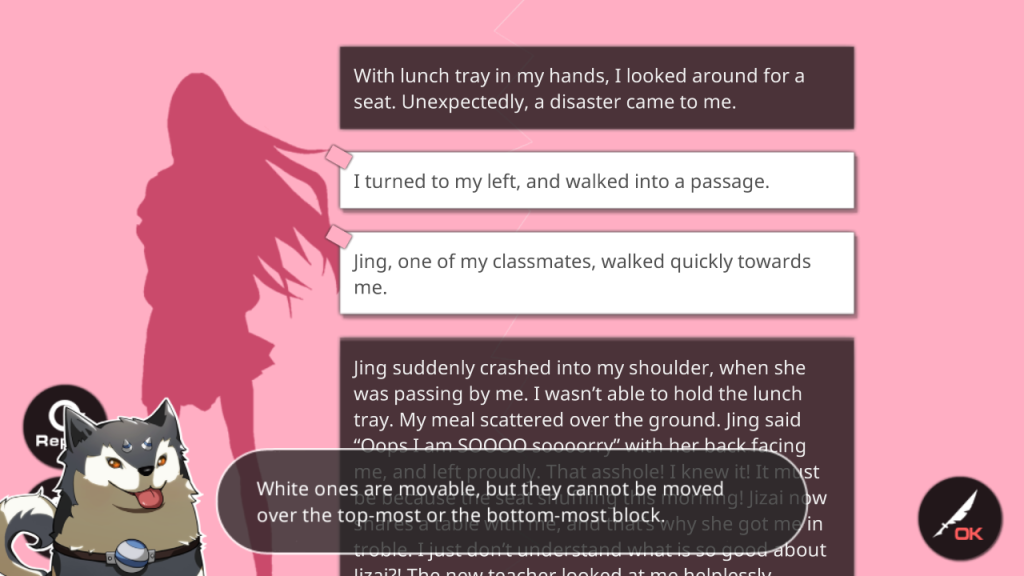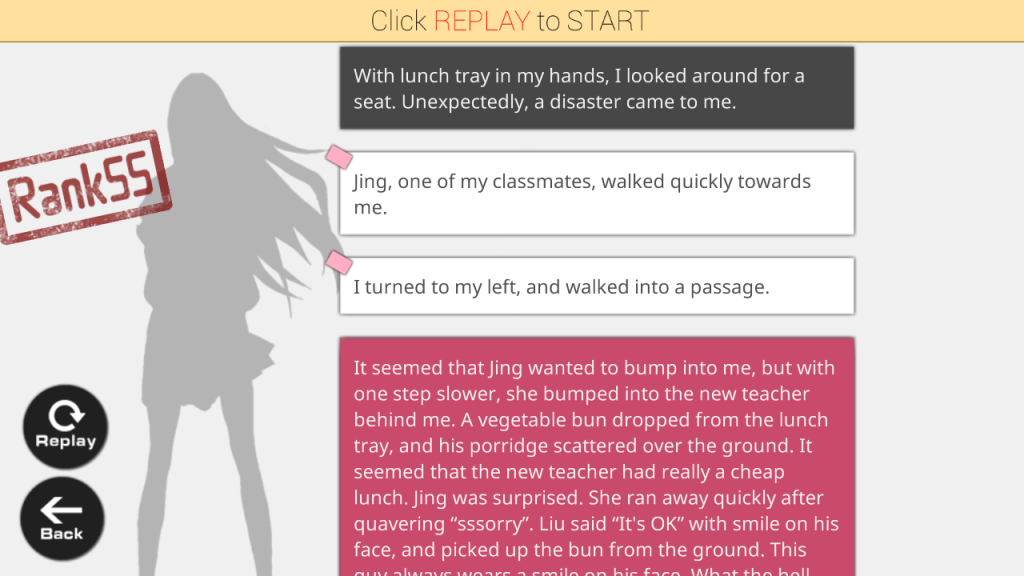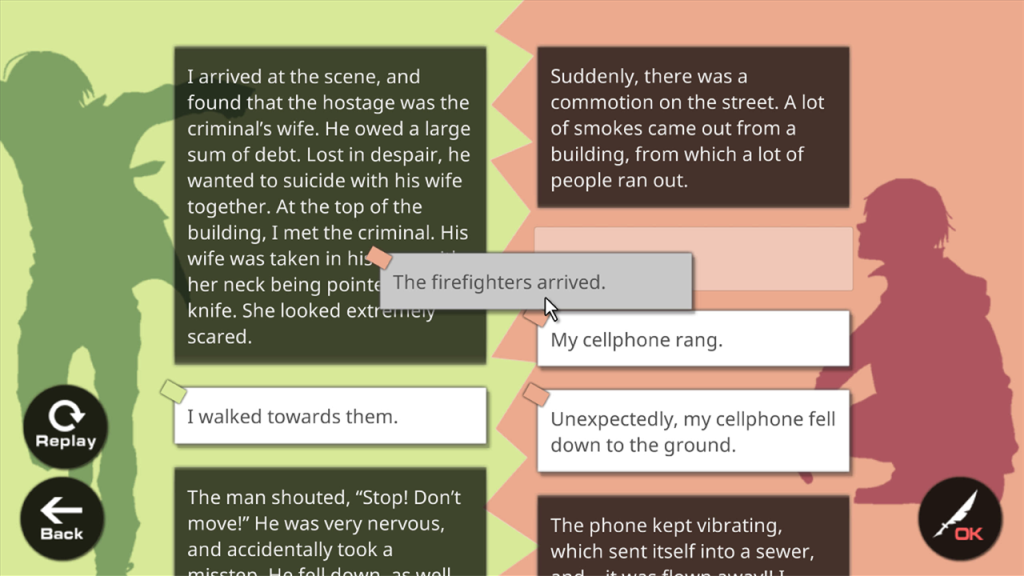Welcome to the Wonderful World!
Hi, I am Miaoyi, the creator of the indie game A Wonderful World. Thank you for visiting this page to know more about this game. :)

A Wonderful World
A Wonderful World is an innovative puzzle game. In this game, mortals write to a “god” for help when they are in trouble, and the “god”—the player—can rearrange the writer’s past described in the fragments of their letters to change their fate.
The major fun of this game is to know the stories happened to characters, and to find how you can affect them. If you play well, more and more stories will be unlocked, and you may gradually discover an incredible butterfly effect. However, if you are not interested in exploring all endings for each story, it is still of fun, as there are already many hidden truths in normal endings for you to dig into.

The protagonists of this game are a girl named Phrasa and a dog named Futurus. Phrasa is a god, who is able to manipulate letter contents to change the writer’s fate. Futurus is Phrasa’s servant. However, both of them actually have other identities. Are you curious now? Play this game and figure it out!
How to Play
The way you play this game is very simple. There are only “tapping” and “dragging”. If you play it on a PC, you use only the left mouse button. White blocks are movable, so you can change their order.

After rearranging the blocks, the player will be able to see their renewed fate.

Compared to single-row levels, in double-row levels, white blocks can be moved not only vertically, but also horizontally.

The best ending unlocks a new story, while other endings are also interesting because some important plots hide there. Therefore, it is also of fun to collect different endings.
Behind the Game
Why I Made A Wonderful World
The idea of A Wonderful World came from one of my favorite comic books, Shinya Shokudō, which tells a story about an eatery opened only after midnights. People with different and even strange jobs come to this eatery for food, and tell their stories. Inspired by this comic book, I want to create a game where the player can help people solving their problems.
So far, I have created 10 characters—9 persons and 1 cat—from 3 different countries with their letters telling their stories. They are student, teacher, policeman, kid, mafia, etc. Our team will design more stories of these characters, and even more characters. With more and more stories unlocked, you will find that those characters are connected, as the thesis of Six Degrees of Separation (a chain of “a friend of a friend” connections can connect any two people in the world in a maximum of six steps).

Another interesting idea is to discover what will happen if we have the power to change the others’ fate in real life. However, the current game demo is too short to dig into this topic. We will add new systems and stories, so that this topic would be further explored and discussed.
History of A Wonderful World
I once worked at NetEase as game engine programmer. To start designing my own games, I resigned from NetEase in October, 2014, preparing to make some really interesting and unique games. My first idea is a puzzle game bigger than A Wonderful World, codenamed “Project Time”. However it turned out to be too costly for me, in both timewise and money-wise. As I gave up “Project Time”, the idea of A Wonderful World came to my mind. It combines RPG and puzzle game, both of which are my favorite game genres.
At the beginning, I made the game mechanics in Excel files. I designed a level, composed it in grids and sent the Excel file to my friends. After they told me their choices, I told them the results. This small game turned out be very successful: my friends told me it was very interesting and wanted to see more of it. Therefore, I decided to develop it into a real game. I took most parts of the work including programming, level design, story, art, UI, etc. Only the illustrations of Phrasa and Futurus, and the BGMs are outsourced with my savings.
The largest difficulty of making the game is to assign endings for every possible combination, in order to gain maximum freedom in the game. The number of possible combinations increases exponentially as the number of possible movements increases. (e.g., two free movements can generate 2 combinations, 3 generate 6, 4 generate 24, 5 generate 120 and 6 generate 720.)
Most of the levels in this game have no less than 5 possible movements, which brings more than 120 different combinations needed to be assigned with reasonable endings exhaustively. One possible solution for the problem is to use a scoring mechanism. However, using a scoring mechanism in a semantic system is a disaster because there is no logical connection between cause and effect. To solve this problem, I design the scheme to classify the combinations into several condition groups, which can guarantee that every possible combination is assigned with a reasonable ending.
Future
Now I have a partner working remotely, but we will start working together from next month (June 2015). There are two other partners who will join us in two months. Most of the members come from Tsinghua University and NetEase, where we have studied or worked together before.Our studio is called Liberal Gate, which means we want to create games with full of imagination. We are going to find a funder this year.
Are You Interested?
We plan to release this game before April, 2016. I hope that everyone loves it. After that, we will try to design a new game in a totally different style but also super interesting.
If you are a publisher or an investor who are interested in A Wonderful World or our team, we will be appreciated if you contact us. For more information about our team, see “About Us”.
No matter you are a story writer, a programmer, a level designer, an artist, a musician, a translator or whatever, if you like our game and want to join us, don’t be shy. Just send us an email!
Finally, thank you for reading this page.